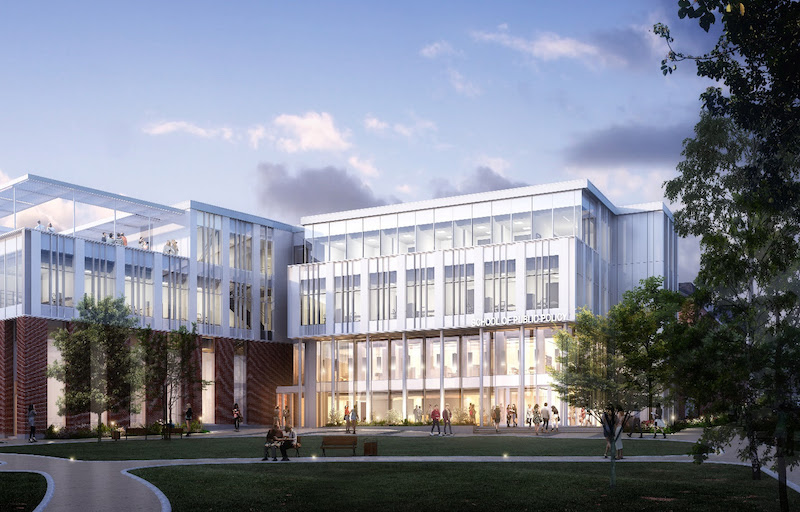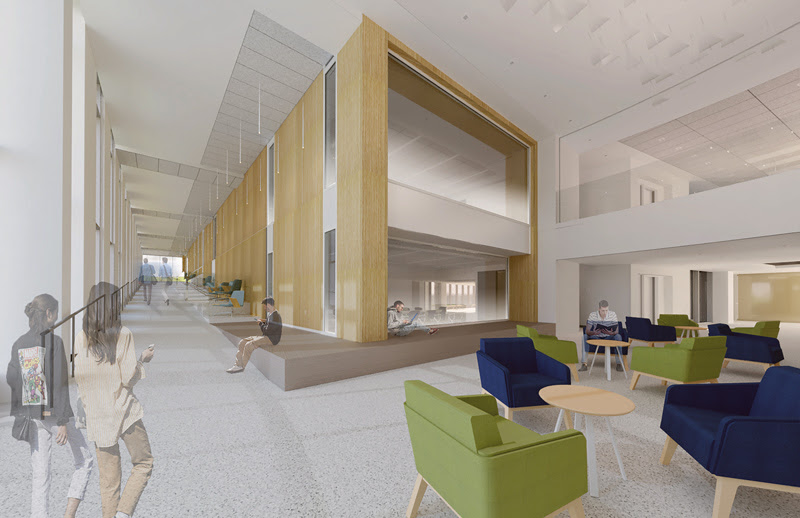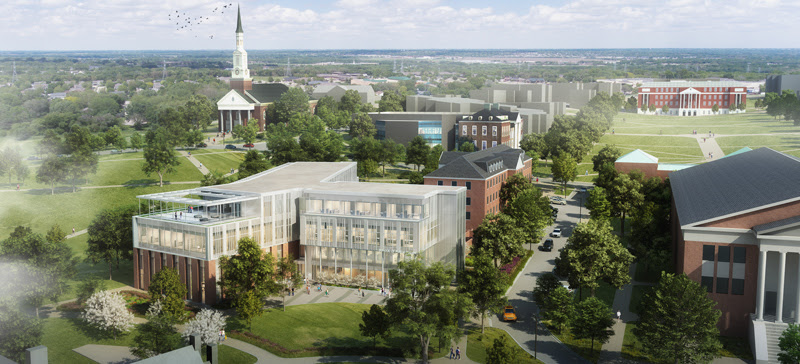The University of Maryland has a new landmark architectural presence in its new School of Public Policy building.
The building’s design concept is rooted in the spatial typology of the ancient Agora, the birthplace of democratic thought and public discourse. The cascading architectural form follows the natural slope of Chapel Field to form an edge to one of the signature open spaces on campus and shape a carefully orchestrated sequence of interior spaces.

Entrances on the east and west sides connect to a large, communal atrium designed to encourage chance meetings, informal study, and interdepartmental collaboration. On the building’s east side is Do Good Plaza, a shared outdoor event space that establishes a new gateway into campus. Brick cladding and white columns connect visually with Lee Hall to the north while the building’s sculpted massing frames Rossborough Inn to the northeast and memorial Chapel to the southwest.

The four-story building brings together the School’s more than 90 faculty members and over 1,000 undergraduate and graduate students and serves as the headquarters for the Do Good Institute, a campus-wide hub for social innovation, philanthropy, and nonprofit leadership. The facility will also include five instructional spaces ranging in size from 25 to 150 seats, a library, and a rooftop terrace.
See Also: South-West Middle School welcomes its first students
The School of Public Policy is expected to achieve LEED Gold rating with biophilic design elements that will connect occupants to nature, reduce the building’s environmental footprint, and provide healthy and productive spaces for work and study.
Related Stories
University Buildings | Apr 24, 2023
Solving complicated research questions in interdisciplinary facilities
University and life science project owners should consider the value of more collaborative building methods, close collaboration with end users, and the benefits of partners who can leverage sector-specific knowledge to their advantage.
Green | Apr 21, 2023
Top 10 green building projects for 2023
The Harvard University Science and Engineering Complex in Boston and the Westwood Hills Nature Center in St. Louis are among the AIA COTE Top Ten Awards honorees for 2023.
Higher Education | Apr 13, 2023
Higher education construction costs for 2023
Fresh data from Gordian breaks down the average cost per square foot for a two-story college classroom building across 10 U.S. cities.
Market Data | Apr 11, 2023
Construction crane count reaches all-time high in Q1 2023
Toronto, Seattle, Los Angeles, and Denver top the list of U.S/Canadian cities with the greatest number of fixed cranes on construction sites, according to Rider Levett Bucknall's RLB Crane Index for North America for Q1 2023.
University Buildings | Apr 11, 2023
Supersizing higher education: Tracking the rise of mega buildings on university campuses
Mega buildings on higher education campuses aren’t unusual. But what has been different lately is the sheer number of supersized projects that have been in the works over the last 12–15 months.
Contractors | Apr 10, 2023
What makes prefabrication work? Factors every construction project should consider
There are many factors requiring careful consideration when determining whether a project is a good fit for prefabrication. JE Dunn’s Brian Burkett breaks down the most important considerations.
Smart Buildings | Apr 7, 2023
Carnegie Mellon University's research on advanced building sensors provokes heated controversy
A research project to test next-generation building sensors at Carnegie Mellon University provoked intense debate over the privacy implications of widespread deployment of the devices in a new 90,000-sf building. The light-switch-size devices, capable of measuring 12 types of data including motion and sound, were mounted in more than 300 locations throughout the building.
Architects | Apr 6, 2023
New tool from Perkins&Will will make public health data more accessible to designers and architects
Called PRECEDE, the dashboard is an open-source tool developed by Perkins&Will that draws on federal data to identify and assess community health priorities within the U.S. by location. The firm was recently awarded a $30,000 ASID Foundation Grant to enhance the tool.
Architects | Apr 6, 2023
Design for belonging: An introduction to inclusive design
The foundation of modern, formalized inclusive design can be traced back to the Americans with Disabilities Act (ADA) in 1990. The movement has developed beyond the simple rules outlined by ADA regulations resulting in features like mothers’ rooms, prayer rooms, and inclusive restrooms.
Sports and Recreational Facilities | Mar 30, 2023
New University of St. Thomas sports arena will support school's move to Division I athletics
The University of St. Thomas in Saint Paul, Minn., last year became the first Division III institution in the modern NCAA to transition directly to Division I. Plans for a new multipurpose sports arena on campus will support that move.
















